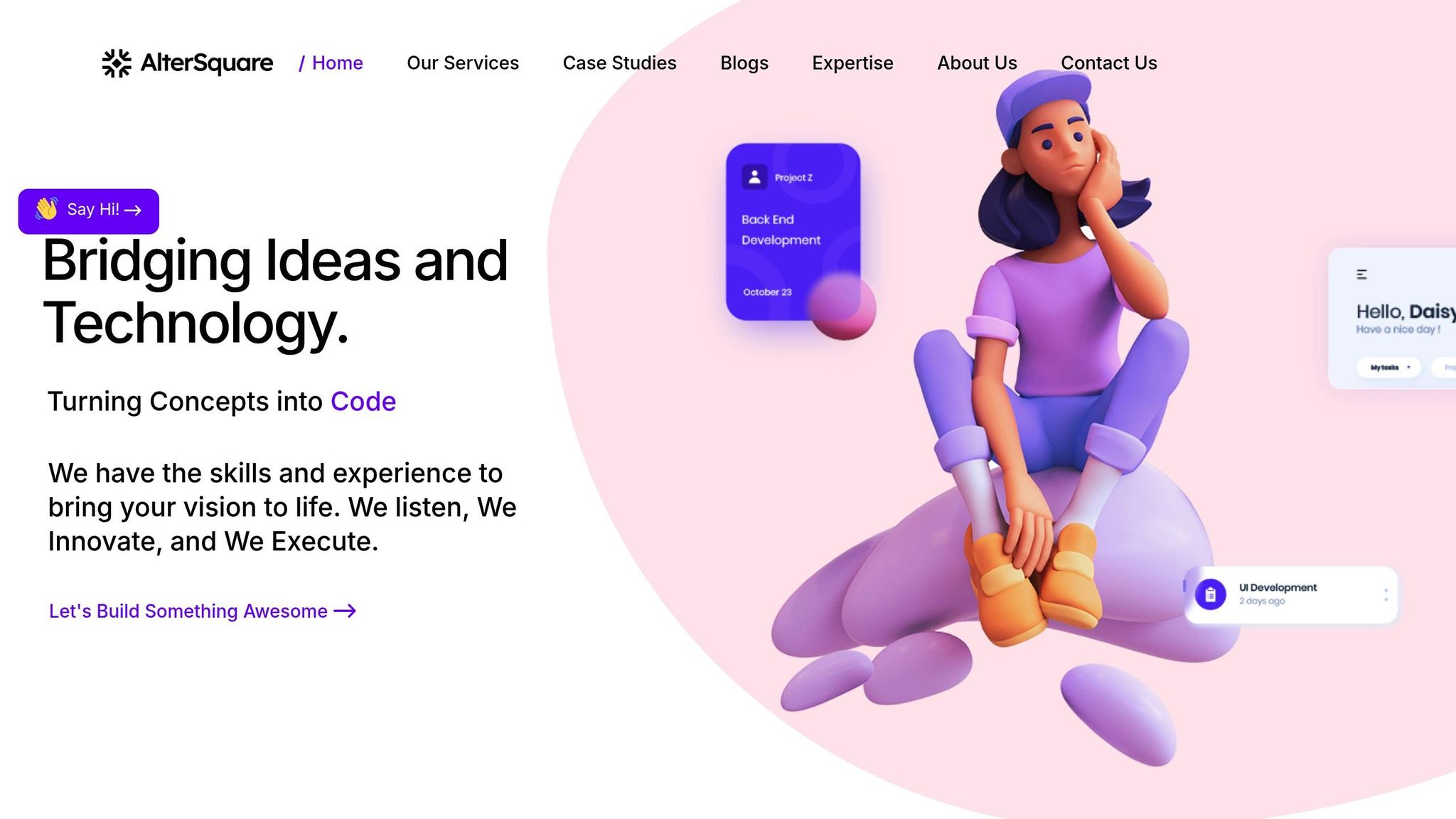How to Budget Effectively for Long-Term Outsourced Product Development
Taher Pardawala March 25, 2025
Here’s how you can plan effectively:
- Define Key Costs: Break down expenses into research, design, development, QA, and management. Know upfront that projects can range from $20,000 to $100,000+.
- Choose the Right Pricing Model: Fixed price for smaller projects; time & materials for flexibility in larger ones.
- Plan for Hidden Costs: Account for delays, extra testing, and post-launch maintenance.
- Start Lean: Focus on a Minimum Viable Product (MVP) and prioritize must-have features.
- Pick the Right Partner: Work with experienced teams that prioritize transparency and agile methods.
- Track and Adjust: Use tools to monitor spending, quality, and progress regularly.
Quick Tip: Add a budget buffer for unexpected expenses. Proper planning ensures your project stays on track without overspending.
Quick Comparison: Fixed Price vs. Time & Materials
| Aspect | Fixed Price | Time & Materials |
|---|---|---|
| Budget Control | Set upfront | Pay as work progresses |
| Flexibility | Limited | High |
| Project Size | Best for small projects | Ideal for larger ones |
| Timeline | Fixed | Flexible |
| Risk | Vendor assumes most risks | Risks shared |
A well-structured budget isn’t just about saving money – it’s about setting your project up for long-term success.
Breaking Down Outsourced Development Costs
Main Cost Components
Outsourcing product development can cost anywhere from $20,000 to over $100,000, depending on your project’s specifics [2]. Here’s a breakdown of the main cost areas:
| Cost Component | Description |
|---|---|
| Research & Development | Includes market research and competitor analysis. |
| Product Design | Covers UI/UX design, wireframing, and prototyping. |
| Software Development | Focuses on building core features and integrations. |
| QA & Testing | Ensures quality control and performance checks. |
| Project Management | Encompasses communication, coordination, and oversight. |
Unexpected Costs to Consider
While initial estimates cover the essentials, unexpected expenses can crop up. For example, working across time zones might require overlapping work hours, and insufficient QA can lead to higher costs after launch. Other potential expenses include:
- Integration needs discovered later in the project
- Delays caused by evolving project requirements
- Extra testing and bug fixes
- Ongoing support and maintenance after launch
- Costs for communication tools or infrastructure
These factors can increase your budget, so it’s smart to account for them early.
Fixed Price vs. Time & Materials: Which to Choose
Your pricing model choice – fixed price or time & materials – has a big impact on budget management. Each works better for different types of projects [3].
| Aspect | Fixed Price | Time & Materials |
|---|---|---|
| Budget Control | Total cost is set upfront | Pay for work as it’s completed |
| Requirement Flexibility | Limited room for changes | Allows for ongoing adjustments |
| Project Size | Best for smaller projects | Works well for larger projects |
| Timeline | Sticks to fixed deadlines | Offers more scheduling flexibility |
| Risk Management | Vendor assumes most risks | Risks are shared between parties |
These models help you balance cost control with flexibility. By understanding the core costs and pricing options, you’ll be better prepared to set a realistic budget for your project.
Building Your Budget Plan
Calculating Development Costs
To estimate your development budget, start by breaking your product into its main features and calculating the time needed for each. Here’s a quick breakdown of typical development components:
| Development Component | Estimated Hours | Cost Range ($) |
|---|---|---|
| Frontend Development | 200–250 | $6,000–$30,000 |
| Backend Development | 250–300 | $7,500–$36,000 |
| Database Design | 50–75 | $1,500–$9,000 |
| API Integration | 75–100 | $2,250–$12,000 |
Hourly rates can range from $30 to $120, depending on the region where you outsource the work [4]. For e-commerce projects, remember to factor in additional costs for payment processing, advanced security, and inventory management features.
Planning for Ongoing Maintenance
After your product launches, maintenance becomes an essential expense to ensure it stays secure, functional, and up to date. Be sure to allocate funds for:
- Security updates and dependency upgrades
- Fixing bugs and improving performance
- Emergency support for urgent issues
- Rolling out periodic updates and new features
Adding Budget Buffers
It’s smart to set aside extra funds for unexpected expenses or changes in project scope. This buffer can cover:
- Adjustments to requirements
- Resolving technical challenges
- Documentation efforts
- Costs for transferring knowledge or training
Ways to Reduce Costs
Start with an MVP
Launching a Minimum Viable Product (MVP) is a smart way to test your idea without overspending. It’s worth noting that 29% of startups fail due to running out of cash before achieving product-market fit [5].
To create a solid MVP:
- Focus on solving one specific problem to define its core value.
- Set clear goals to measure user engagement and retention.
- Use short development cycles (2–3 weeks) to keep momentum and control expenses.
Focus on Must-Have Features
Keep your initial product simple by focusing on essential features. Categorize features into:
- Must-Have: Features critical for basic functionality.
- Should-Have: Features that enhance value but aren’t necessary for launch.
- Nice-to-Have: Features that can wait for future updates.
This approach ensures you’re delivering meaningful value without inflating costs.
Select the Right Development Partner
The development partner you choose plays a big role in managing costs and achieving success. A skilled partner can help you save money by:
- Spotting potential problems early to avoid expensive fixes later.
- Streamlining processes to minimize waste and speed up delivery.
- Offering insights to prioritize features and make smarter technical decisions.
When evaluating partners, prioritize those with a strong history in MVP development, transparent pricing, milestone-based payments, and a focus on agile practices for flexibility and cost control.
sbb-itb-51b9a02
Guide to Outsourcing Software Development Сost
Long-Term Financial Planning
Once you’ve created your initial budget, it’s time to focus on long-term financial planning to ensure your project stays on track.
Setting Payment Milestones
Tie payments to specific deliverables instead of arbitrary timelines. Break your project into phases like discovery, design, core development, testing, and launch. For example, divide core development into smaller payments based on key feature completions and quality checks. This approach ensures payments align with progress and encourages accountability.
Monitor and Adjust Spending
Use project management tools to keep an eye on spending and progress. Regular reviews help identify issues early. To stay on top of costs:
-
Hold regular video calls and share concise progress reports. Weekly meetings should cover:
- Spending vs. budget projections
- Updates on feature development
- Testing results and quality metrics
- Resource allocation efficiency
-
Track key performance metrics, such as:
- Code quality
- Bug detection rates
- Sprint completion rates
- Overall development speed
- Document all change requests with details on technical impact, costs, timelines, and priorities.
These steps help you maintain financial discipline throughout the project.
Budget for Growth
Planning for future scalability is crucial to avoid costly rebuilds down the line. Set aside resources for expansion while keeping development lean.
"Outsourcing product development can save costs, provide access to global talent, and help startups scale quickly." – AlterSquare [1]
Incorporate automated testing tools early to cut debugging costs and speed up deployments. When planning for growth, consider factors like:
- Cloud service scalability
- Strengthened security measures
- Performance improvements
- Database management
- Upgrades for third-party integrations
Budget Management Tools
Once you’ve outlined your cost estimates and growth plans, it’s time to use tools that help you keep your budget on track.
Project Budget Tracking Software
Tracking software gives you a clear view of costs as they happen. Many project management platforms include features tailored for outsourced development, such as:
- Cost breakdown structure: Track expenses by feature, sprint, or milestone.
- Developer hours and rates: Monitor time and costs for your team.
- Change request tracking: Log scope changes and their financial impact.
- Automated reports: Generate custom reports without manual effort.
- Integrations: Sync with accounting and invoicing systems.
Set up the software to track both fixed and variable costs. You can also enable alerts to notify you when spending approaches your set limits.
Budget Planning Templates
Using standardized templates helps maintain consistency across all project phases, from setup to maintenance. Here’s a breakdown of what these templates can include:
| Template Section | Key Elements | Purpose |
|---|---|---|
| Initial Setup | Development environment, licenses, tools | One-time costs |
| Sprint Planning | Developer hours, testing resources, QA | Recurring costs |
| Risk Management | Contingency funds, buffer allocation | Financial safety |
| Maintenance | Ongoing support, updates, hosting | Long-term costs |
These templates should be treated as evolving documents. Update them regularly to reflect real project performance and any changes in requirements. Consistent reviews will keep them accurate and useful.
Budget Performance Metrics
Keep an eye on these key metrics to evaluate how well you’re managing your budget:
- Burn rate: Track daily or weekly spending against your projections.
- Feature completion cost: Compare the estimated and actual costs for each feature.
- Development velocity: Measure story points completed per dollar spent.
- Quality metrics: Assess costs related to bug fixes and technical debt.
- ROI indicators: Evaluate the business value achieved versus development costs.
Dashboards can help you visualize these metrics, making it easier to spot trends or issues. Regularly review the data with your team to stay aligned on financial goals and make adjustments as needed. These tools work well alongside your broader financial strategy.
Conclusion: Steps to Better Budgeting
Key Budget Planning Tips
Planning a budget for outsourced product development isn’t just about cutting costs – it’s about making smart choices that bring value. While 59% of companies outsource mainly to save money [4], a solid budget plan should go beyond that. Here are some practical tips:
- Keep detailed records of all expenses, including changes to the project scope.
- Allocate resources flexibly to match evolving project needs.
- Regularly review progress to make timely spending adjustments.
- Account for post-launch maintenance in the initial budget.
- Reserve funds for unexpected technical hurdles.
Now, here’s how to turn these tips into action.
Getting Started
Follow these steps to kickstart better budgeting:
1. Define Your MVP Scope
Outline a clear Minimum Viable Product (MVP) to test essential features while keeping costs under control.
2. Build a Budget Framework
Plan for all key expenses, including:
- Development costs
- Maintenance and updates
- Quality assurance
- Knowledge transfer between teams
- Communication tools and platforms
3. Set Up Monitoring Systems
Track these metrics to stay on top of spending:
- Daily and weekly burn rates
- Costs tied to feature completion
- Development speed and progress
- Quality benchmarks
- Return on investment (ROI)
AlterSquare‘s Services

AlterSquare can help you streamline your budgeting process with services like:
- Expert technical consultations for cost-efficient solutions
- Transparent pricing, complete with detailed expense tracking
- Milestone-based payment plans with regular progress checks
- Comprehensive post-launch support strategies
- Scalable development teams to adapt to your needs
Their I.D.E.A.L Delivery Framework includes a 90-day MVP development cycle, designed to manage resources efficiently while ensuring your product can scale as needed.
Smart budget planning isn’t a one-time task – it’s an ongoing process. By following these steps, you’ll create a budget that supports your project’s long-term success.
Related posts
- The Complete Beginner’s Guide to Outsourcing Your First Tech Product
- Offshore, Nearshore, or Onshore: Which Outsourcing Model Is Right for Your Startup?
- The Hidden Costs of DIY vs. Outsourced Development – and How to Avoid Them
- Top 5 Ways Startups Can Reduce Costs While Working with Outsourced Teams








Leave a Reply